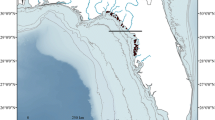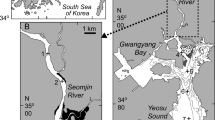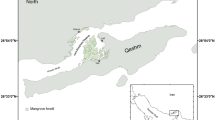Abstract
The nitrogen and carbon stable isotope ratios (δ15N and δ13C) of the pygmy mussel,Xenostrobus securis, were determined for three estuaries with varying levels of catchment disturbance in northern New South Wales, Australia. The lower Manning River catchment supported the highest human population densities with 3% residential development and some livestock agriculture (41%); the Wallamba River catchment was mostly livestock agriculture (56%) while the Wallingat River catchment was mostly vegetated (79%). Mussels, estuarine particulate organic matter (POM), and livestock and human-derived waste were collected in two stages during the austral summers of 2001–2002 and 2002–2003 for dual carbon-nitrogen stable isotope analysis. The disturbed Manning and Wallamba River catchment mussels were enriched in15N by an average of 3.2‰ and 1.5‰, respectively, compared to the vegetated Wallingat River mussels. Mussel δ13C values ranged from −24.8‰ to −30.3‰ and showed an estuarine gradient becoming enriched with distance downstream within estuaries, but were unable to distinguish patterns in catchment disturbance between estuaries. The δ15N and δ13C values of POM showed a similar pattern to mussels, indicating a direct link between them within each estuary. A multiple regression model of mussel δ15N using the fractions of land used for livestock agriculture and residential development within 5 km zones from river networks to a distance equivalent to a tidal ellipse from sites explained 67% of the variation in mussel δ15N with 95% of the differences lying within 1.6‰ of observed values. Increasing fractions of land used for livestock agriculture depleted mussel δ15N values estimated by the regression equation, indicating the use of cow manure as a nutrient source with a value of 2.0‰. Increasing fractions of land used for residential development enriched estimated mussel δ15N, indicating the use of human-derived waste with a value of 20.8‰. Pygmy mussels are a useful long-term bio-indicator for the effects of anthropogenic catchment disturbance and nutrient enrichment in estuaries.
Similar content being viewed by others
Literature Cited
Allen, Y. C., B. A. Thompson, andC. W. Ramcharan. 1999. Growth and mortality rates of the zebra mussel,Dreissena polymorpha, in the Lower Mississippi River.Canadian Journal of Fisheries and Aquatic Sciences 56:748–759.
Allsop, D. and R. Kadluczka. 1999. Wallis Lake estuary tidal data collection March–June 1998. New South Wales Department of Public Works and Services and Manly Hydraulics Laboratory, MHL927, Manly Vale, New South Wales.
Bland, M. J. andD. G. Altman. 1986. Statistical methods for assessing agreement between two methods of clinical measurement.Lancet i:307–310.
Boutton, T. W. 1991. Stable Carbon Isotopic Ratios of Natural Materials: II. Atmospheric, Terrestrial, Marine and Freshwater Environments. Academic Press, San Diego, California.
Cantillo, A. Y. 1998. Comparison of results of Mussel Watch Programs of the United States and France with world-wide mussel watch studies.Marine Pollution Bulletin 36:712–717.
Carpenter, S. R., N. F. Caraco, D. L. Correll, R. W. Howarth, A. N. Sharpley, andV. H. Smith. 1998. Nonpoint pollution of surface waters with phosphorus and nitrogen.Ecological Applications 8:559–568.
Cloern, J. E. 2001. Our evolving conceptual model of the coastal eutrophication problem.Marine Ecology Progress Series 210:223–253.
de Jonge, V. N. andM. Elliott. 2001. Eutrophication, p. 852–870.In J. Steele, S. Thorpe, and K. Turekian (eds.), Encyclopaedia of Ocean Studies. Academic Press, London.
de Jonge, V. N., M. Elliott, andE. Orive. 2002. Causes, historical development, effects and future challenges of a common environmental problem: Eutrophication.Hydrobiologia 475/476: 1–19.
De Niro, M. J. andS. Epstein. 1978. Influence of diet on the distribution of carbon isotopes in animals.Geochimica et Cosmochimica Acta 42:495–506.
De Niro, M. J. andS. Epstein. 1981. Influence of diet on the distribution of nitrogen isotopes in animals.Geochimica et Cosmochimica Acta 45:341–351.
Evgenidou, A. andI. Valiela. 2002. Response of growth and density of a population ofGeukensia demissa to land-derived nitrogen loading, in Waquoit Bay, Massachusetts.Estuarine Coastal and Shelf Science 55:125–138.
Fry, B. 1999. Using stable isotopes to monitor watershed influences on aquatic trophodynamics.Canadian Journal of Fisheries and Aquatic Sciences 56:2167–2171.
Gaston, T. F. andI. M. Suthers. 2004. Spatial variation in d13C and d15N of liver, muscle and bone in a rocky reef planktivorous fish: The relative contribution of sewage.Journal of Experimental Marine Biology and Ecology 304:17–33.
Hallegraeff, G. M. andS. W. Jeffrey. 1975. New spectrophotometric equations for determining chlorophylls a, b, c1, and c2 in higher plants, algae and natural phytoplankton.Biochemie und Physiologie der Pfanzen 167:191–194.
Heaton, T. H. E. 1986. Isotopic studies of nitrogen pollution in the hydrosphere and atmosphere: A review.Chemical Geology 59:87–102.
Hobson, K. A., R. T. Alisauskas, andR. G. Clark. 1993. Stable-nitrogen isotope enrichment in avian tissues due to fasting and nutritional stress: Implications for isotopic analysis of diet.Condor 94:181–188.
Jones, A. B., M. J. O'Donohue, J. Udy, andW. C. Dennison. 2001. Assessing ecological impacts of shrimp and sewage effluent: Biological indicators with standard water quality analysis.Estuarine Coastal and Shelf Science 52:91–109.
Kang, C. K., P.-G. Sauriau, P. Richard, andG. F. Blanchard. 1999. Food sources of the suspension-feeding bivalveCerastoderma edule in a muddy sandflat of Marennes-Oléron Bay, as determined by analyses of carbon and nitrogen stable isotopes.Marine Ecology Progress Series 187:147–158.
Lake, J. L., R. A. McKinney, F. A. Osterman, R. J. Pruell, J. Kiddon, S. A. Ryba, andA. D. Libby. 2001. Stable nitrogen isotopes as indicators of anthropogenic activities in small freshwater systems.Canadian Journal of Fisheries and Aquatic Sciences 58:870–878.
McClelland, J. W. andI. Valiela. 1998. Linking nitrogen in estuarine producers to land-derived sources.Limnology and Oceanography 43:577–585.
McClelland, J. W., I. Valiela, andR. H. Michener. 1997. Nitrogen-stable isotope signatures in estuarine food webs: A record of increasing urbanization in coastal watersheds.Limnology and Oceanography 42:930–937.
McKinney, R. A., J. L. Lake, M. A. Charpentier, andS. Ryba. 2002. Using mussel isotope ratios to assess anthropogenic nitrogen inputs to freshwater ecosystems.Environmental Monitoring and Assessment 74:167–192.
Meeuwig, J. J. 1999. Predicting coastal eutrophication from land-use: An empirical approach to small non-stratified estuaries.Marine Ecology Progress Series 176:231–241.
Michener, R. H. andD. M. Schell. 1994. Stable isotope ratios as tracers in marine aquatic food webs, p. 138–157.In K. Lajtha and R. H. Michener (eds.), Stable Isotopes in Ecology and Environmental Science. Blackwell Scientific Publications, Oxford, U.K.
Nedwell, D. B., L. F. Dong, A. Sage, andG. J. C. Underwood. 2002. Variations of the nutrients loads to the mainland U.K. estuaries: Correlation with catchment areas, urbanization and coastal eutrophication.Estuarine Coastal and Shelf Science 54:951–970.
Paterson, K. J., M. Schreider, andK. D. Zimmerman. 2003. Effect of catchment disturbance on seston quality and quantity in Brisbane Water, NSW.Estuarine Coastal and Shelf Science 56:355–368.
Peterson, B. J., R. W. Howarth, andR. H. Garritt. 1986. Sulfur and carbon isotopes as tracers of salt-marsh organic matter flow.Ecology 67:865–874.
Richard, P., P. Riera, andR. Galois. 1997. Temporal variations in the chemical and carbon isotope compositions of marine and terrestrial organic inputs in the Bay of Marennes-Oléron, France.Journal of Coastal Research 13:879–889.
Rogers, K. M. 1999. Effects of sewage contamination on macroalgae and shellfish at Moa Point, New Zealand using stable carbon and nitrogen isotopes.New Zealand Journal of Marine and Freshwater Research 33:181–188.
Scharler, U. M. andD. Baird. 2003. The influence of catchment management on salinity, nutrient stoichiometry and phytoplankton biomass of Eastern Cape estuaries, South Africa.Estuarine Coastal and Shelf Science 56:735–748.
Thornton, S. F. andJ. McManus. 1994. Application of organic carbon and nitrogen stable isotope and C/N ratios as source indicators of organic matter provenance in estuarine systems: Evidence from the Tay estuary, Scotland.Estuarine Coastal and Shelf Science 38:219–233.
Viarengo, A. andL. Canesi. 1991. Mussels as biological indicators of pollution.Aquaculture 94:225–243.
Wilson, B. R. 1969. Survival and reproduction of the musselXenostrobus securis (Lamarck) (Mollusca: Bivalvia: Mytilidae) in a Western Australian estuary. Pt. II: Reproduction, growth and longevity.Journal of Natural History 3:93–120.
Sources of Unpublished Materials
Geoscience Australia. unpublished data. Jerrabomberra Avenue (crn Hindmarsh Drive), Canberra, ACT 2600, Australia.
Great Lakes Council. unpublished data. Breese Parade, Forster, NSW 2428, Australia.
Greater Taree City Council. unpublished data. 2 Pultney Street, Taree, NSW 2430, Australia.
New South Wales Department of Environment and Conservation Water Science Unit. unpublished data. 59 Goulburn Street, Sydney, NSW 2000, Australia.
Author information
Authors and Affiliations
Corresponding author
Rights and permissions
About this article
Cite this article
Moore, S.K., Suthers, I.M. Can the nitrogen and carbon stable isotopes of the pygmy mussel,Xenostrobus securis, indicate catchment disturbance for estuaries in northern New South Wales, Australia?. Estuaries 28, 714–725 (2005). https://doi.org/10.1007/BF02732910
Received:
Revised:
Accepted:
Issue Date:
DOI: https://doi.org/10.1007/BF02732910




